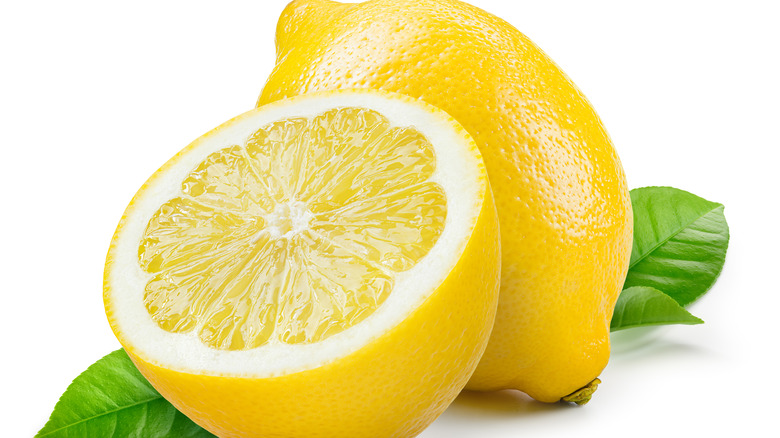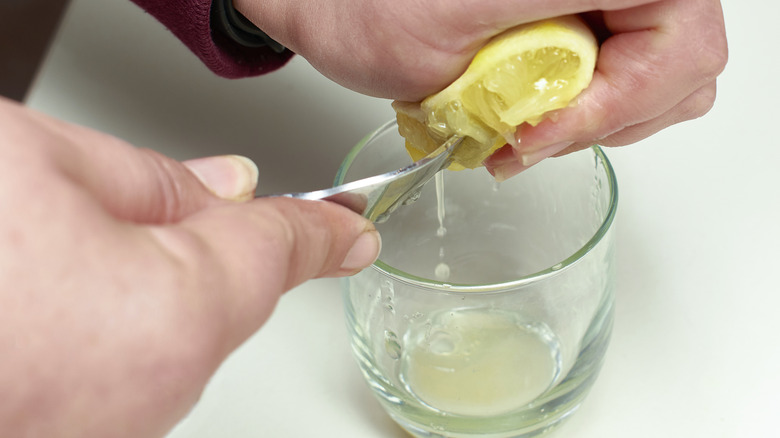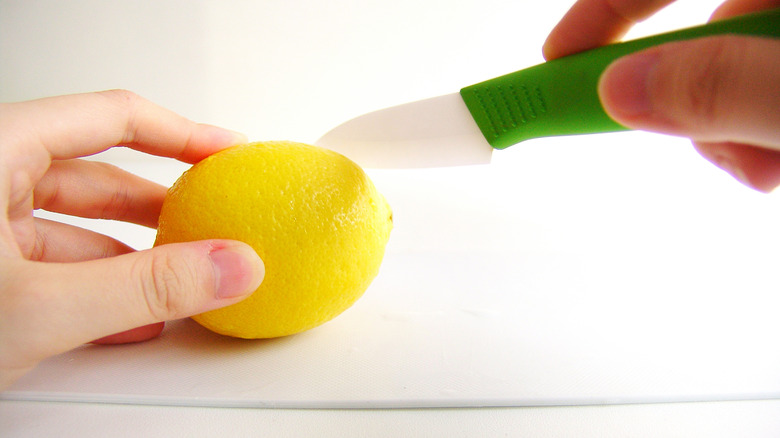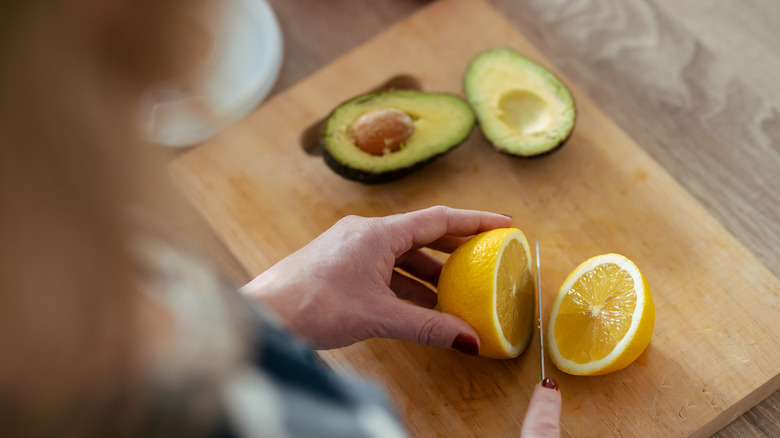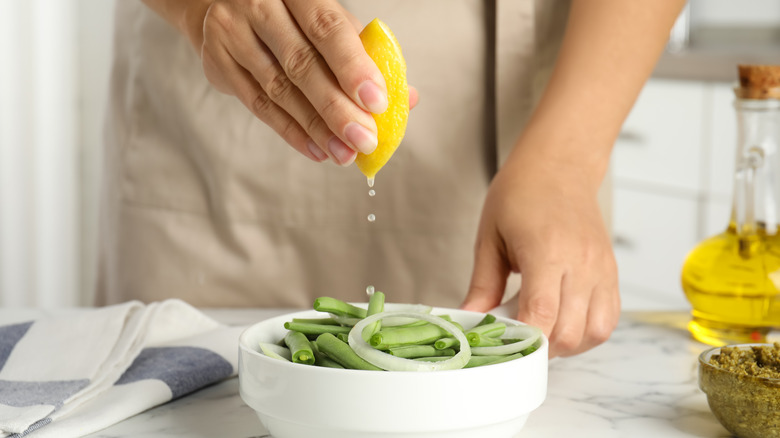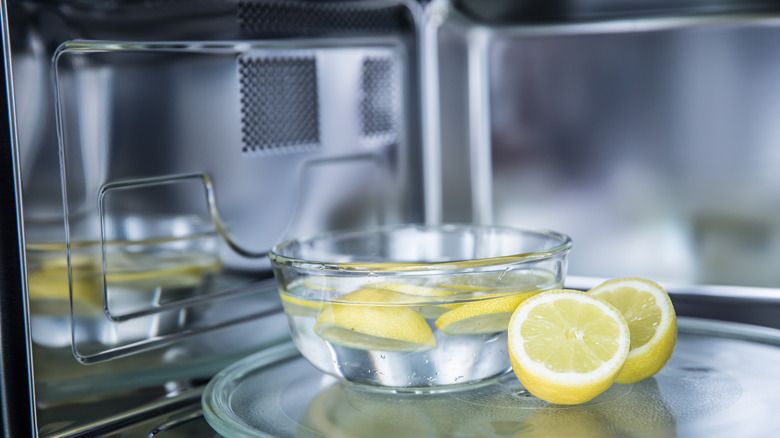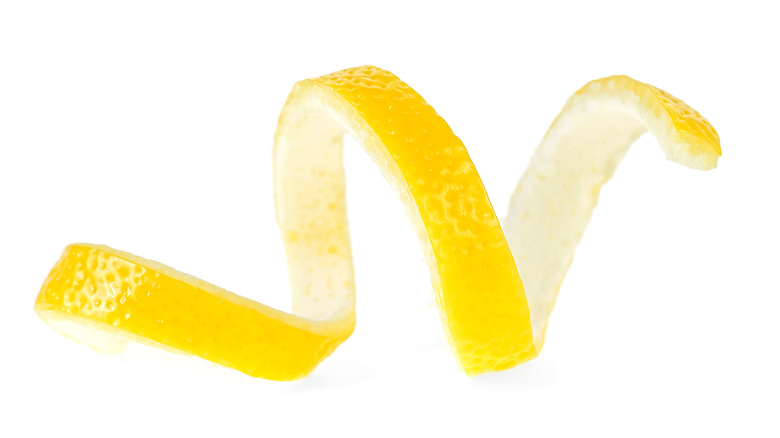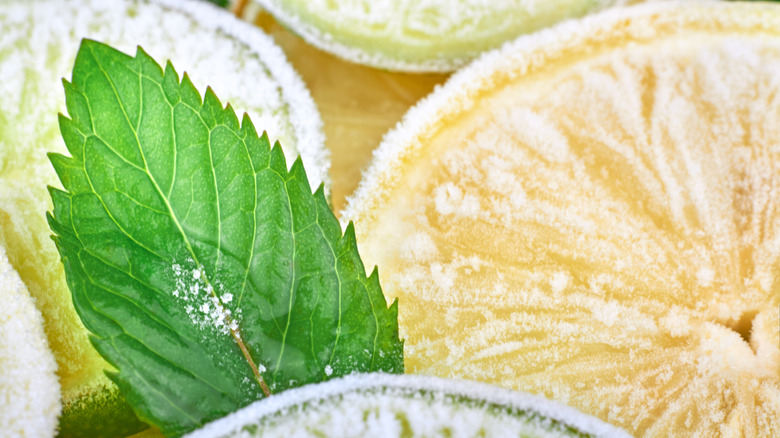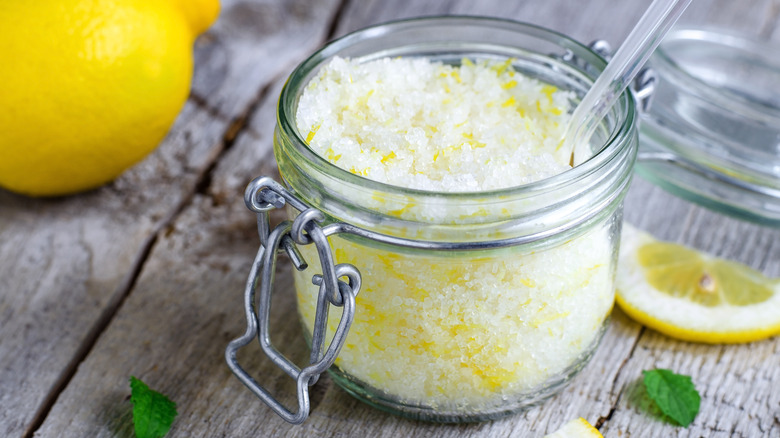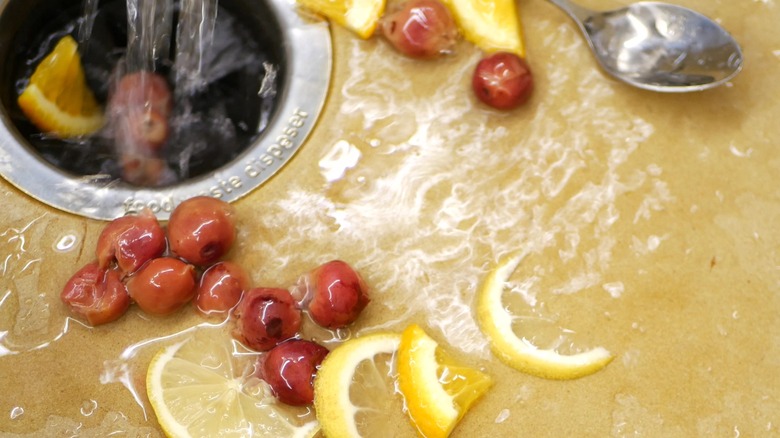Stop Making These Mistakes With Lemons
When pop music sensation Trini Lopez sang, "Lemon tree, very pretty, and the lemon flower is sweet. But the fruit of the poor lemon is impossible to eat," he only got it half right. Lemon trees are indeed quite beautiful and fragrant, but the yellow citrus they produce is cultivated and consumed by people around the world, proving the beloved 1960s crooner wrong.
We all know lemons are rich in vitamin C, fiber, and minerals, and internist Roxanne B. Sukol, MD, MS, from the Cleveland Clinic even recommends consuming lemon water each morning to help digestion, prevent cell oxidation, and halt the formation of kidney stones. The bitter truth, however, is that most people don't take advantage of the manifold other uses for this versatile fruit. Lemons can also do more harm than good in particular situations — another sour reality. In order to get the most out of your lemons, steer clear of these common mistakes.
Not squeezing out the most juice possible
Why leave any of that sweetly sour ambrosia inside of a lemon when there's a formula for squeezing the most juice out of any citrus? First things first: Do not cut your lemons before you've properly prepared them. Start by cleaning it — especially if you plan on consuming the rinds – then soak the whole fruit in warm water. This trick softens the lemon peel, making it easier to press, mash, or twist. Further soften the rind by rolling the intact lemon on a hard, flat table or countertop to break open the individual membranes. Alternatively, zapping the lemon in the microwave for 10 seconds can also soften it and make it easier to juice.
Unless you're using a juicer, cut your lemons width-wise, which opens up more of the flesh of the fruit and makes it easier to get the most juice out as possible. Help move things along by using a fork to break open the individual membranes surrounding the lemon flesh. Now you're ready to juice!
Not cutting lemon wedges properly
Nothing says class quite like a perfectly-sliced lemon wedge on a dinner platter or cocktail glass. To cut Michelin-star quality slices every time, remove between ½" and 1" from the stem end and bottom of the lemon, giving it a barrel shape (via The Culinistas). Stand the lemon on one of the flat sides and slice it in into quarters. Take each quarter and remove the pith (the stringy part inside the lemon), the white membrane edge of the flesh, and any remaining seeds. Cut two equal wedges out of each quarter, giving you eight per lemon. Your lemon wedges are now ready to garnish your dish or drink.
One thing to bear in mind is that lemons are round and therefore can roll when you are making the initial cuts, so be careful. Once the first cut is made, lay the slice down flat to make cutting the additional slices a little easier.
Not using lemon juice to store avocados
Avocados are delicious and rich in heart-healthy fats, but according to the World Economic Forum, frenzied demand for this fruit has a considerable impact on climate change. Avocado farming causes deforestation and loss of biodiversity, making it especially important not to let this resource-intensive food go to waste. Because avocados contain an enzyme called polyphenol oxidase, the moment its soft, green flesh comes in contact with the air it begins to oxidize. In next to no time at all, a cut avocado can go from "Ooh!" to "Ugh."
One trick to delay the browning of avocados is to add a little lemon juice to their flesh, which can keep them looker fresh for around 24 hours. Other best practices include leaving the pit in and sealing the avocado in an air container. While you can't prevent oxidation altogether, the acids in the lemon juice and the air-tight seal can help halt oxidation from progressing and keep your avocado edible for longer, reducing the waste of these precious resources.
Not letting lemon save dishes you've over-seasoned
It happens to the best of home cooks. Sometimes, one flavor seems to overwhelm an entire dish, threatening to turn the whole meal into extraordinarily well-seasoned compost. And while it's difficult to remove flavors that have already been added to a dish, chef Curtis Stone told the Rachel Ray Show that it's certainly possible to rescue a meal in some other way. Once again, the magical lemon swoops in and saves the day.
Over-sweetened your meal? Let the magical lemon work its wonders as the fruit's acidity helps to balance the sweetness in a dish. Too much salt? Dilute what you can, then add lemon to hide your goof-up. Is the whole batch just "meh"? Squeeze in some (perfectly-wedged) lemon to turn your meal from flat to fabulous in no time. That's three more great reasons to always keep your pantry stocked with this multifaceted fruit.
Not cleaning your microwave with lemons
The acidic nature of lemon makes it an excellent cleaning agent, especially for your microwave. The same chemical compound that gives lemons their zingy flavor also acts as an antiseptic, removing bacteria, mildew, and mold — all without the use of irritating synthetic chemicals. Oils housed inside the lemon rind can help remove stains and eliminate grease, and the fragrance of the fruit itself can neutralize unwanted odors, making lemons the perfect choice to keep your microwave looking and smelling new.
Simply add one cup of water to a bowl. Slice a lemon in half, squeeze the juice into a bowl, add the lemon halves back in, then microwave the bowl for around five minutes or until boiling (via Homes and Gardens). Instead of removing the bowl immediately and wiping down the microwave, allow the lemon steam to help loosen crusty food particles from the interior microwave walls for around five minutes. Dip a reusable cloth or sponge into the lemon solution to continue cleaning. Afterwards, the lemons can be retired to the compost bin.
Not using lemon peels to their fullest potential
After you've finished juicing lemons for your fresh squeezed lemonade (or perhaps some yummy Meyer lemon margaritas), you're left with the flavorful rinds. Instead of treating these remnant lemon parts as mere trash, consider them a useful addition to your kitchen's flavor kit. Lemon rinds baked with root vegetables and potatoes can provide an entirely new dimension to your cooking — and your sustainability journey – with no part of the lemon going to waste. Lemon zest, the outer yellow peel of the fruit, is scraped off using a variety of tools and makes a great topping for cocktails, desserts, and sauces.
You can always add remaining lemon peels to your broth bag — an air-tight freezer bag where the less appetizing-looking parts of your produce live before becoming homemade vegetable stock. However you use the entire lemon, make sure to leave out the seeds; their extra bitter flavor is best suited for the compost.
Not freezing lemons to keep them from spoiling
If you have more fresh lemons on hand than you know what to do with, one very easy zero-waste tip is to slice them widthwise and freeze them for future use (via Natasha's Kitchen). Start by washing, drying, and cutting the lemon, then lay the slices on a baking sheet lined with parchment or wax paper. Pat the lemons dry to prevent ice crystals from damaging the flesh of the fruit, then place the baking sheet in the freezer for at least eight hours. Once the slices are frozen solid, you can remove them from the tray and store them in a freezer-safe container. When carefully preserved, they will stay fresh for up to three months or even longer.
You can also freeze whole lemons. This method is certainly faster than slicing, but once defrosted, your lemon will be best suited for baking or cooking — not for presentational lemon wedges. Store your frozen whole lemon in an airtight container, then thaw it at room temperature, especially if you plan on zesting the rind. You can even freeze lemon juice and zest for later use.
Not home crafting with lemon rinds
All those lemon rinds can do more than transform your cooking skills. Double down on your zero-waste actions by turning them into DIY crafts you — or someone you love — can enjoy. Noble Pig's Lemon-Salt Body Scrub recipe is about as easy as it gets. Simply combine Epsom salt, a cup of body oil of your choice, and as much lemon zest as your heart desires. Repurpose a glass jar to hold your new scrub, and you're not only exfoliating your elbows, but you're also reducing your carbon footprint — truly a win-win situation.
If you're willing to go through the process of drying your lemon peels — either on the countertop or in a dehydrator — you can even make your own citrus potpourri. Combine the dry lemon rinds with spices, flowers, pine cones, and even essential oils in a repurposed glass jar, and shake it to release the delicious scents. Ahhh...
Not freshening your garbage disposal with them
And if you're like most people, you're regularly putting food down your garbage disposal that you shouldn't. Week-old pasta, tooth-scraped artichoke leaves, and fully-spent coffee grounds can get stuck on the disposal walls or nearby pipes. Live in an older building? This situation is even more likely. And the food that accumulates inside the disposal — even if it's run regularly — can create unpleasant smells.
Thankfully, just a single lemon (or even lemons left over from juicing or cleaning) can be fed into the disposal as wedges, giving your sink — and kitchen — a fresh aroma. Dried lemon peels boast an even more significant benefit for garbage disposal maintenance. The hardened fruit coatings can help clean the disposal blades, and the oils trapped inside can help deodorize any remaining food particles. Using lemons this way means everything but the seeds have at least a second, if not third, use.
Eating too many lemons when you have acid reflux
For most people, the recommendation to drink water with half a lemon's worth of juice every day can help keep you hydrated and, for just 6 calories, gives you ⅙ of your vitamin C intake for the day (via Cleveland Clinic). But if you struggle with acid reflux or gastroesophageal reflux disease (GERD), this might be too much lemon (via Medical News Today). Still, a study published in the Journal of Clinical Biochemistry and Nutrition shows that consuming ascorbic acid, the naturally occurring form of vitamin C, can prevent damage to the cells in the stomach and help protect from particular types of cancers, with specific benefits for people with peptic ulcers.
Additionally, research in mice indicates that eating lemon compounds can help people lose and then maintain their weight. Since losing weight can help reduce the symptoms of acid reflux, consuming lemon could be beneficial for this reason, too.
So how much is too much? One tablespoon of lemon juice in a standard 8-ounce glass of water can produce an alkalizing effect and reduce reflux symptoms. The combination with water is crucial to neutralize stomach acids. Sucking directly on lemon wedges can damage the enamel on your teeth, so GERD sufferers are advised to drink this slightly acidic water 20 minutes before meals to help neutralize stomach acid.
Eating lemon slices from the bar
Folks with suppressed immune systems, take note. Cut lemons you see balanced on the rims of water glasses and cocktails everywhere may be hosts to viruses and bacteria, most notably E. coli. Research from 2007 found nearly 70% of lemons sampled from 21 restaurants over 43 visits contained microbial growth. And while most people's immune systems can easily fight off this bacteria, some strains of E.coli can cause diarrhea, respiratory issues including pneumonia, infections of the urinary tract, and additional illnesses. The immunocompromised are at even greater risk: One study found that E. coli had unexpectedly caused an abscess in the hip muscles of a leukemia patient.
Utensils, chopping boards, and food service employees' hands can all serve as vectors for contamination. Research conducted by Clemson University in 2017 demonstrated that wet lemons had a bacterial transfer rate of 100% (dry lemons had a 70% transfer rate), indicating the danger involved in consuming sliced lemons.
This is especially true for lemons at self-serve stations. Other consumers may have handled the pre-cut fruit wedges, increasing the risk of contamination, and lemon slices kept at room temperature are breeding grounds for E. coli. Trini Lopez was right: For some people, the fruit of the poor lemon is impossible to eat. At least when dining out.
